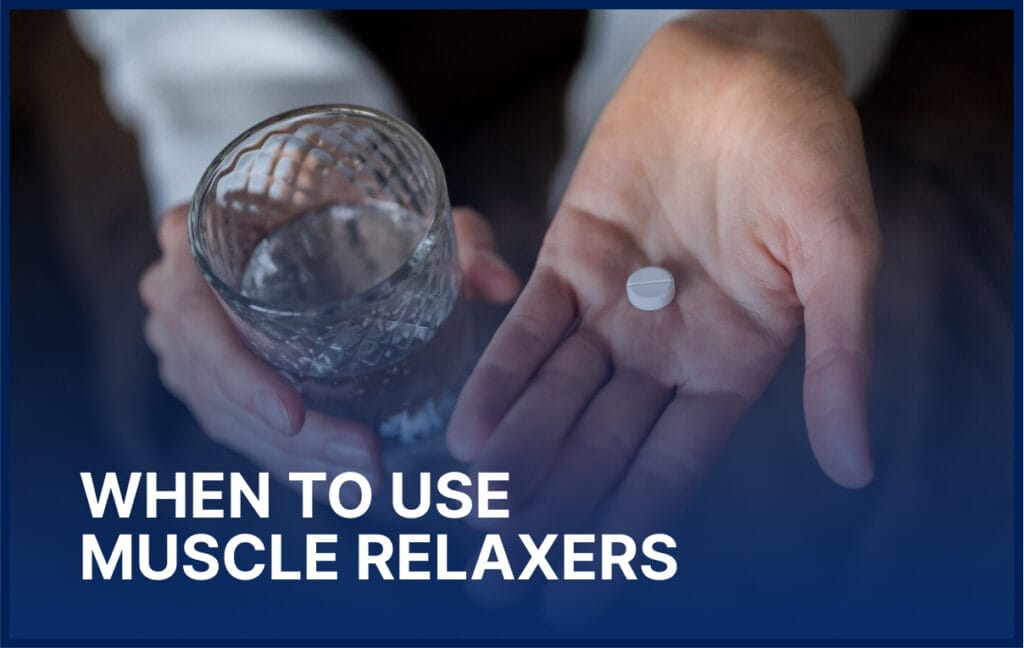Muscle relaxers come to the rescue when our bodies scream in pain and rebellion. These medications can turn the tide in our favor, easing muscle tension and offering a much-needed reprieve. But understanding their full potential and knowing when to use them is crucial if you want to use them safely and effectively.

Benefits of Muscle Relaxers
Pain Relief and Muscle Spasm Reduction
Muscle relaxers shine brightest when it comes to pain relief and reducing muscle spasms. Imagine a tight knot in your back after a long day or a sudden, painful spasm that catches you off guard. Muscle relaxers work by interfering with the signals your brain sends to your muscles, effectively reducing the pain and relaxing the spasms. This relief is often immediate, bringing comfort and ease back into your daily routine.
Improved Mobility and Functionality
Beyond just alleviating pain, muscle relaxers significantly enhance mobility and functionality. Think of how debilitating a stiff neck, period cramps, or a tight back can be. These medications help your muscles loosen up, making movements more fluid and less painful. It’s like giving your body a well-deserved break, allowing you to move freely and with confidence.
Short-term vs. Long-term Use
Muscle relaxers are typically prescribed for short-term relief, perfect for acute conditions like a muscle spasm or injury. Long-term use, however, is usually not recommended due to potential side effects and the risk of dependency. Your healthcare provider can guide you on the best course of action based on your specific situation.

When to Use Muscle Relaxers
Indications for Use
Muscle relaxers are indicated in various situations where pain and spasms disrupt daily activities. Acute injuries, chronic pain conditions, and certain neurological disorders are common scenarios where these medications prove beneficial. The goal is to restore comfort and functionality, helping you regain control over your body.
Conditions Treated with Muscle Relaxers
Muscle relaxers are versatile in their application. They treat conditions like lower back pain, neck pain, fibromyalgia, and even multiple sclerosis. Each of these conditions involves muscle tightness or spasms that can be effectively managed with muscle relaxers, providing significant relief.
When to Consult a Doctor
Consulting a healthcare provider before starting muscle relaxers is paramount. A professional can determine the appropriate medication, dosage, and duration based on your condition and overall health. Self-medicating can lead to unwanted complications, so professional guidance can lead to safer and more effective use.
Related Article: Best OTC and Natural Muscle Relaxers

Safe Usage and Potential Side Effects
Recommended Dosage and Administration
Adhering to the recommended dosage and administration guidelines is crucial for safe usage. Overuse or misuse can lead to serious health issues. Your doctor will prescribe the appropriate dosage based on your medical history, current condition, and response to the medication. Following these instructions maximizes the benefit while minimizing the risk.
Common Side Effects
Like all medications, muscle relaxers come with potential side effects. Common ones include drowsiness, dizziness, dry mouth, and fatigue. While these side effects are generally mild and temporary, it’s essential to be aware of them. Knowing what to expect can help you manage these effects and continue your treatment comfortably.
Risks and Precautions
There are risks and precautions to consider with muscle relaxers. They can interact with other medications, leading to adverse effects. Additionally, there’s a potential for dependency with long-term use. It’s crucial to follow your doctor’s guidance and report any unusual symptoms immediately.

Alternatives to Muscle Relaxers
Physical Therapy
Physical therapy is a non-drug alternative that can effectively manage muscle pain and spasms. Through targeted exercises and stretches, physical therapists help improve muscle strength and flexibility. This approach not only alleviates pain but also addresses the underlying causes, promoting long-term health and wellness.
Over-the-Counter Pain Relievers
Over-the-counter pain relievers like ibuprofen and acetaminophen are accessible alternatives to muscle relaxers. These medications can reduce inflammation and relieve pain without the need for a prescription. They’re particularly useful for mild to moderate pain and can be used in conjunction with other treatments for comprehensive pain management.
Lifestyle Changes and Home Remedies
Lifestyle changes and home remedies play a significant role in managing muscle pain and spasms. Regular exercise, a balanced diet, adequate hydration, and proper posture can prevent muscle issues and improve overall health. Home remedies like warm baths, apple cider vinegar, and applying heat or cold packs can provide immediate relief and promote muscle relaxation.

Tips for Maximizing the Benefits of Muscle Relaxers
Combine with Physical Therapy
Pairing muscle relaxers with a robust stretching and strengthening regimen can significantly amplify their effects. Regular physical therapy sessions are essential, as they help promote long-term relief and promote improved muscle health. Consistency in these sessions allows your muscles to adapt and recover more effectively. Additionally, working with your therapist to develop personalized exercise plans tailored to your specific needs can make a significant difference. These plans help you target the right areas and avoid any movements that could exacerbate your condition.
Mind Your Diet and Hydration
Staying hydrated is crucial for muscle health. Water acts as your muscles’ best friend, helping them stay flexible and function properly. Aim for at least eight glasses of water a day to keep your muscles well-hydrated. Alongside hydration, balanced nutrition plays a vital role. Foods rich in magnesium, calcium, and potassium support muscle function and prevent menstrual cramps. On the flip side, it’s wise to minimize caffeine and alcohol intake as these can exacerbate muscle tension and counteract the benefits of muscle relaxers.
Adopt a Holistic Approach
Adopting a holistic approach can further enhance the benefits of muscle relaxers. Practices like yoga and meditation are excellent for reducing muscle tension and stress. These mindfulness techniques promote relaxation, helping your muscles unwind. Make sure you get adequate rest and sleep, since sleep is a vital period for muscle recovery and regeneration. Lastly, paying attention to ergonomics and posture can make a significant difference. Adjusting your workspace and daily activities to maintain proper posture reduces strain on muscles and prevents future discomfort.
Common Myths About Muscle Relaxers Debunked
Myth: Muscle Relaxers Cure the Underlying Issue
- Fact: Muscle relaxers provide symptom relief but don’t address the root cause of muscle pain or spasms.
- Explanation: They help manage pain and improve mobility, allowing other treatments to work more effectively.
Myth: Muscle Relaxers are Addictive
- Fact: When used as prescribed, muscle relaxers are safe and have a low risk of dependency.
- Explanation: Long-term use should be monitored by a healthcare provider to prevent potential dependency.
Myth: Over-the-Counter Pain Relievers are Just as Effective
- Fact: While OTC pain relievers can help, muscle relaxers are specifically designed to target muscle spasms and severe pain.
- Explanation: They work on a different mechanism, providing targeted relief that OTC medications may not offer.
Pick The Muscle Relaxer You Need Today
Using muscle relaxers effectively and safely involves understanding their benefits, indications, and potential risks. Remember to consult your healthcare provider before starting any medication, adhere to prescribed dosages, and be mindful of side effects. Explore alternatives like physical therapy and lifestyle changes, like limiting sugar-intake, to complement your treatment and promote overall well-being.


